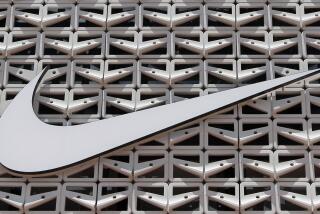L.A. Gear Loses $8.2 Million in Its 1st Quarter
L.A. Gear Inc., whose athletic shoe business has been tumbling for the better part of the last two years, said Monday that it lost another $8.2 million in the first quarter as sales declined nearly 30% from the year before.
In addition, the troubled shoe maker said it expects its business to suffer for the remainder of the year because of accumulated unsold inventories.
The problems, the company added, will prevent it from paying dividends to its preferred shareholder, Trefoil Capital Investors, which currently owns a 34% stake in the company, for the rest of 1992. As a result, Trefoil will gain a majority control of L.A. Gear’s board of directors beginning in late August.
Monday’s announcement is yet another indication of the severity of the problems that have plagued the nation’s third-largest athletic shoe maker since late 1990 and have forced it to seek outside investors and a completely new management team.
The company grew in less than a decade from its origins as a maker of trendy sneakers for teen-aged girls into an athletic shoe powerhouse that at its peak in 1990 had sales of more than $900 million. But problems began even as the company was enjoying its peak sales.
Among the company’s ills have been a crumbling consumer economy and intensifying competition from market leaders Nike and Reebok.
In addition, poor marketing decisions by L.A. Gear executives left the company serving neither the fashion end of the athletic shoe business favored by women and younger consumers nor the so-called “high performance” athletic segment favored by teen-age boys. Sales began softening in the final months of 1990 and hit the skids last year, when the company lost a total of $67.8 million.
In the first quarter of 1992, ended Feb. 29, the company had sales of $109.6 million, down 29.5% from the $155.3 million posted in the prior year period when it had a loss of $12.5 million.
William L. Benford, senior vice president and chief financial officer, said problems are expected to persist for the remainder of the year.
Although the company is trying to reduce its inventory of unsold goods through discounts and other sales incentives, the efforts were too late to have any effect in the first quarter. In fact, inventories in the first quarter increased by about 776,000 pairs of shoes, or 7.6%, Benford said. But Benford said the inventory-slashing efforts are expected to reduce the company’s profit margins throughout the current year, “which will negatively impact the results of operations for the year.”
More to Read
Inside the business of entertainment
The Wide Shot brings you news, analysis and insights on everything from streaming wars to production — and what it all means for the future.
You may occasionally receive promotional content from the Los Angeles Times.










